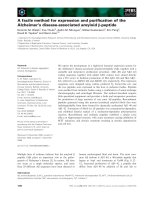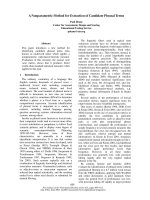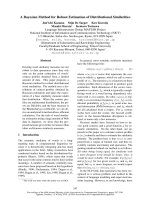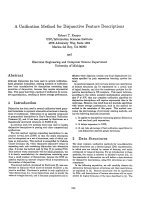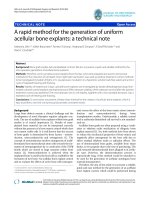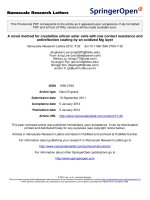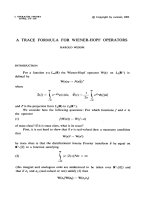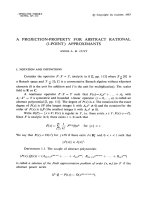Báo cáo toán học: "A construction method for complete sets of mutually orthogonal frequency squares" pdf
Bạn đang xem bản rút gọn của tài liệu. Xem và tải ngay bản đầy đủ của tài liệu tại đây (68.05 KB, 3 trang )
A construction method for complete sets of
mutually orthogonal frequency squares
VCMavron
Department of Mathematics,
University of Wales,
Aberystwyth, SY23 3BZ
U.K.
Submitted: May 17, 2000; Accepted: August 22, 2000.
Abstract
A construction is described for combining affine designs with complete sets of
mutually orthogonal frequency squares to produce other complete sets.
Key words: Matrices, orthogonal arrays, Latin squares, affine designs.
AMS subject classifications: Primary 05B20, Secondary 05B05, 05B15.
1 Introduction
A frequency square M of type F(n; λ)isann×n matrix over an m-set S,wheren = λm,
such that every element of S occurs exactly λ times in each row and each column of M.
When λ =1,F is a latin square.
Two frequency squares of the same type over S are orthogonal if, when one is
superimposed on the other, each element of S × S appears λ
2
times. These definitions
accord with those in [1, Chap.20], where can be found a survey of frequency squares.
A set of (n − 1)
2
/(m − 1) mutually orthogonal frequency squares (MOFS) of type
F (n; λ)isacomplete set of type F (n; λ).
We shall describe a construction for complete sets of MOFS using another set of
MOFS and an affine design. A special case is Laywine’s construction [2] (see also
IV.20.8(3) in [1]), which uses a complete set of MOLS in place of the MOFS and the
affine design has the parameters of the design of the points and hyperplanes of some
affine geometry.
With the usual design theory notation, an affine design AD(k, m)isanaffine
2-(v, k, λ)design,withv = km, λ =(k − 1)/(m − 1), whose blocks can be partitioned
1
the electronic journal of combinatorics 7 (2000), #N5 2
into r =(km− 1)/(m − 1) subsets of m blocks, called parallel classes, such that any two
blocks from different parallel classes meet in exactly µ = k/m = k
2
/v points.
Any AD(m, m) is an affine plane of order m. A classical theorem of Bose states that
an affine plane of order m exists if and only if there exists a complete set of orthogonal
frequency squares of type F (m; 1); that is, a complete set of mutually orthogonal latin
squares (MOLS) of order m.
2 The construction
The construction that is described in the following theorem provides a way of generating
complete sets of MOFS but assumes the existence of affine designs with suitable param-
eters. However, the known AD(k, m) designs have either m =2and2k is the order of
a Hadamard matrix, or else m is a prime power and k apowerofm.
Theorem 1 Suppose there exists an AD(k,m) and a complete set of MOFS of type
F (kmλ; λ). Then there exists a complete set MOFS of type F(kmλ; kλ).
Proof. Let Γ be an AD(k, m). Then Γ has exactly km points. Therefore we can assume
the given complete set is defined over the point set of Γ.
Let C be any of the (km − 1)/(m − 1) parallel classes of Γ and F be any of the type
F (kmλ; λ) frequency squares. Then we define as follows a kmλ× kmλ frequency square
M.
If 1 ≤ i, j ≤ kmλ and F
ij
= α,whereα is a point of Γ, let C
β
be the unique block
of C on α in Γ, where 1 ≤ α ≤ m. Then we define M
ij
= β.
To show M is a frequency square, let i (1 ≤ i ≤ kmλ)andβ (1 ≤ β ≤ m)begiven.
There are k points α of Γ on C
β
and then, for each such α, there are λ values of j for
which F
ij
= α (since F is an F (kmλ; λ) frequency square). Hence β occurs exactly
kλ times in any row of M; and this is also true for columns by a similar argument.
Therefore M is a type F(kmλ; kλ)square.
Next we show that by varying C and F we obtain a complete set of MOFS.
Let C
be a parallel class of Γ and F
any of the given type F(kmλ; λ) frequency
squares. Let M
be the corresponding type F (kmλ; kλ) frequency squares defined as
before.
Assume M = M
. Then we show that M and M
are orthogonal. Let 1 ≤ β,β
≤ m.
We count that number of order pairs i, j for which M
ij
= β and M
ij
= β
.
FirstconsiderthecaseF = F
.Letα be any of the k points on C
β
and α
any point
on C
β
.SinceF, F
are orthogonal, there are λ
2
ordered pairs i, j such that F
ij
= α and
F
ij
= α
. Hence there are k
2
λ
2
ordered pairs i, j for which M
ij
= β and M
ij
= β
.
Next consider the case F = F
.ThenC = C
. Choose α to be any of the k/m points
in the intersection of C
α
and C
α
. Then there are exactly kmλ
2
ordered pairs i, j for
which F
ij
= α,sinceα occurs λ times in each row of F . For such a pair i, j it follows
that M
ij
= β and M
ij
= β
;sothereareexactlykmλ
2
× k/m = k
2
λ
2
such pairs.
the electronic journal of combinatorics 7 (2000), #N5 3
It follows that M and M
are orthogonal.
Now there are (km− 1)/(m − 1) possible parallel classes and (kmλ −−1)
2
/(km− 1)
possible F . Hence we have (kmλ−1)
2
/(m−1) frequency squares M; that is, a complete
set of type F(kmλ; kλ), as required.
Corollary 2 If there exists an affine plane of order km (or equivalently a complete set
of MOLS of order km) and an AD(k, m), then there exists a complete set of MOFS of
type F (km; k).
Proof. This is the case λ = 1 of the theorem.
Remark 3 Laywine proves the above corollary (see [1, IV.20.8(3)],[2] or [3]) for the
case when k is a power of m.
Corollary 4 If there exists an affine plane of order m and complete set of type F (λm
2
; λ),
then there exists a complete set of type F (λm
2
; λm).
Proof. This is the special case k = m of the theorem.
It follows from Corollary 4 that a type F(m
2
; m) complete set exists if m and m
2
areordersofaffineplanes.
Corollary 5 If there is a Hadamard matrix of order 2k and a complete set of type
F (2kλ; λ), then there exists a complete set of type F(2kλ; kλ).
Proof. This follows from the theorem, putting m = 2 and noting the well known result
[1, IV.24.8, p371] that an AD(k, 2) exists if and only if there exists a Hadamard matrix
of order 2k.
By a result of Federer and Mandeli [1, IV.20.9, p355], a type F(4t;2t) complete set
exists if there exists a Hadamard matrix of order 4t. Note that Corollary 5 asserts
the existence of a type F (2kλ; kλ) complete set without requiring the existence of a
Hadamard matrix of order 2kλ. (Though of course such a matrix will exist if the
Hadamard conjecture is true.)
References
[1] C J Colbourn, J H Dinitz (eds.): The CRC Handbook of Combinatorial Designs
(CRC Press, 1996).
[2] C F Laywine, A geometric construction for sets of mutually orthogonal frequency
squares, Utilitas Math. 35 (1989), 95-102.
[3] C F Laywine, G L Mullen: Discrete Mathematics Using Latin Squares (Wiley, 1998).
